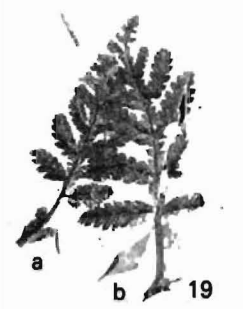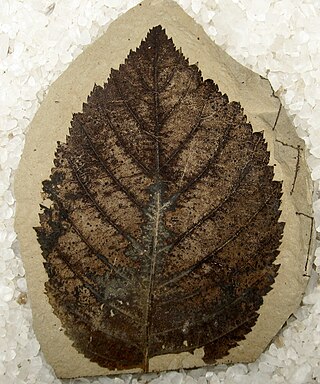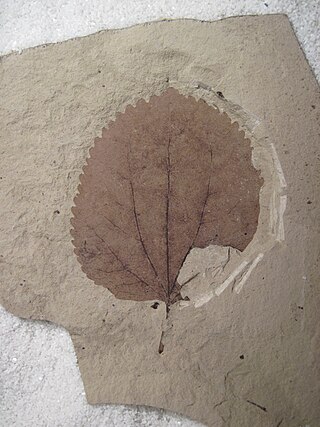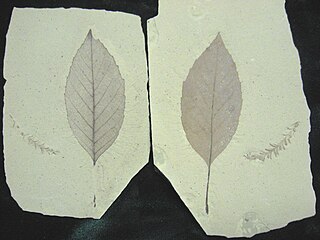
Tilia johnsoni is an extinct species of flowering plant in the family Malvaceae that, as a member of the genus Tilia, is related to modern lindens. The species is known from fossil leaves found in the early Eocene deposits of northern Washington state, United States and a similar aged formation in British Columbia, Canada.
Neviusia dunthornei is an extinct species of flowering plants in the family Rosaceae. The species is solely known from the early Eocene, Ypresian stage, Allenby Formation Lacustrine deposits near the town of Princeton, British Columbia.

Corylopsis reedae is an extinct species of flowering plant in the family Hamamelidaceae known from fossil leaves found in the early Eocene Klondike Mountain Formation deposits of northern Washington state. C. readae is one of the oldest occurrences of the winter-hazel genus Corylopsis, which includes between seven and thirty species, all found in Asia. Fossils from two other occurrences are of similar age to C. readae, with Paleocene specimens from Greenland being placed in the form taxon Corylopsiphyllum and an Eocene Alaskan fossil being included in Corylopsis without species placement.

Stonebergia is an extinct genus in the rose family, Rosaceae, which contains the single species Stonebergia columbiana. The genus was described from a series of isolated fossil leaves in shale from an early Eocene location in southern British Columbia.

Rhus malloryi is an extinct species of flowering plant in the sumac family Anacardiaceae. The species is known from fossil leaves found in the early Eocene deposits of northern Washington state, United States. The species was first described from a series of isolated fossil leaves in shale. R. malloryi is one of four sumac species to be described from the Klondike Mountain Formation, and forms a hybrid complex with the other three species.

Langeria is an extinct genus of flowering plants in the family Platanaceae containing the solitary species Langeria magnifica. Langeria is known from fossil leaves found in the early Eocene deposits of northern Washington state, United States and similar aged formations in British Columbia, Canada.

Ulmus okanaganensis is an extinct species of flowering plant in the family Ulmaceae related to the modern elms. The species is known from fossil leaves, flowers, and fruits found in the early Eocene deposits of northern Washington state, United States and similar aged formations in British Columbia, Canada.

Betula leopoldae is an extinct species of birch in the family Betulaceae. The species is known from fossil leaves, catkins, and inflorescences found in the early Eocene deposits of northern Washington state, United States, and similar aged formations in British Columbia, Canada. The species is placed as basal in Betula, either as a stem group species, or an early divergent species.

Rhus boothillensis is an extinct species of flowering plant in the sumac family Anacardiaceae. The species is known from fossil leaves found in the early Eocene deposits of northern Washington State, United States. The species was first described from fossil leaves found in the Klondike Mountain Formation. Rhus boothillensis likely hybridized with the other Klondike Mountain formation sumac species Rhus garwellii, Rhus malloryi, and Rhus republicensis.

Rhus garwellii is an extinct species of flowering plant in the sumac family Anacardiaceae. The species is known from fossil leaves found in the early Eocene deposits of northern Washington State, United States. The species was first described from fossil leaves found in the Klondike Mountain Formation. R. garwellii likely hybridized with the other Klondike Mountain formation sumac species R. boothillensis, R. malloryi, and R. republicensis.
Rhus republicensis is an extinct species of flowering plant in the sumac family, Anacardiaceae. The species is known from fossil leaves found in the early Eocene deposits of northern Washington state in the United States. The species was first described from fossil leaves found in the Klondike Mountain Formation. R. republicensis likely hybridized with the other Klondike Mountain formation sumac species Rhus boothillensis, Rhus garwellii, and Rhus malloryi.

Tetracentron hopkinsii is an extinct species of flowering plant in the family Trochodendraceae. The species is known from fossil leaves found in the early Eocene deposits of northern Washington state, United States and south Central British Columbia. The species was first described from fossil leaves found in the Allenby Formation. T. hopkinsii are possibly the leaves belonging to the extinct trochodendraceous fruits Pentacentron sternhartae.

Comptonia columbiana is an extinct species of sweet fern in the flowering plant family Myricaceae. The species is known from fossil leaves found in the early Eocene deposits of central to southern British Columbia, Canada, plus northern Washington state, United States, and, tentatively, the late Eocene of Southern Idaho and Earliest Oligocene of Oregon, United States.

Barghoornia is an extinct genus of flowering plants in the family Burseraceae containing the solitary species Barghoornia oblongifolia. The species is known from fossil leaves found in the early Eocene deposits of northern Washington state, United States.

Carpinus perryae is an extinct species of hornbeam known from fossil fruits found in the Klondike Mountain Formation deposits of northern Washington state, dated to the early Eocene Ypresian stage. Based on described features, C. perryae is the oldest definite species in the genus Carpinus.

Equisetum similkamense is an extinct horsetail species in the family Equisetaceae described from a group of whole plant fossils including rhizomes, stems, and leaves. The species is known from Ypresian sediments exposed in British Columbia, Canada. It is one of several extinct species placed in the living genus Equisetum.

Fagus langevinii is an extinct species of beech in the family Fagaceae. The species is known from fossil fruits, nuts, pollen, and leaves found in the early Eocene deposits of South central British Columbia, and northern Washington state, United States.

Ulmus chuchuanus is an extinct species of flowering plant in the family Ulmaceae related to the modern elms. The species is known from fossil leaves and fruits found in early Eocene sites of northern Washington state, United States and central British Columbia, Canada.

Alnus parvifolia was an extinct species of flowering plant in the family Betulaceae related to the modern birches. The species is known from fossil leaves and possible fruits found in early Eocene sites of northern Washington state, United States, and central British Columbia, Canada.

Republica is an enigmatic genus of flowering plants which includes three known species: Republica hickeyi, Republica kummerensis, and Republica litseafolia. The genus has been found in Eocene age geologic formations along the Pacific coast of North America. The affiliations of Republica are uncertain, with the most recent placement being tentatively in the now broken up subclass Hamamelididae.



















